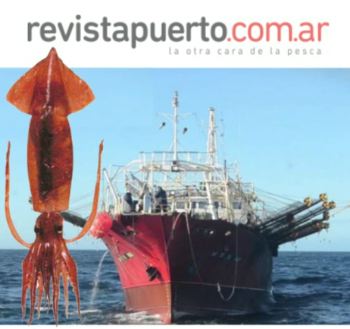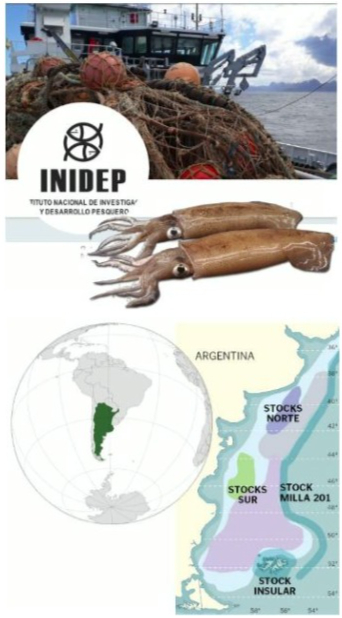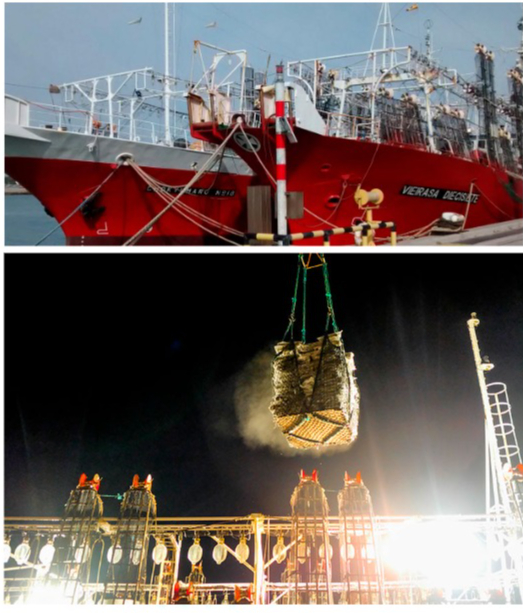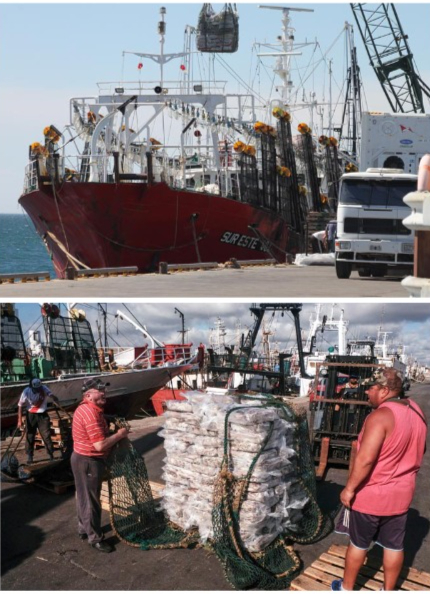|

Photo courtesy from Revista Puerto
Squid illex 2023: 'The fleet is fishing well, similar to last year'
 ARGENTINA
ARGENTINA
Friday, February 03, 2023, 06:40 (GMT + 9)
Marcela Ivanovic (INIDEP) summarized the first three weeks of the start of the Argentine squid season, which shows very similar parameters to previous harvests, with 66 jigger boats fishing this week and a catch that has already reached 30,000 tons. They propose a new system to determine the escape and define the closure.
 Marcela Ivanovic Marcela Ivanovic knows that in these first days of the year it is a required source of information for those who seek data on what is happening in the Argentine squid fishery, the first to gain momentum in the fishing industry. As every year, the head of the Cephalopod Fisheries Program receives us in her office on the first floor of INIDEP to present the first data of the 2023 harvest, summarize what happened last year and reveal details of the Dynamic Early Warning System, a method in which they work with the aim of making the escape of squid more flexible at the end of the season.
REVISTA PUERTO: What are you seeing in these first days of the harvest?
 MARCELA IVANOVIC: That started well, similar to the previous year and also to 2021. The fleet is fishing in the usual area, between 45º and 47º South, the summer spawning stock. Until the first report we made that covered up to January 23, 16,000 tons had been caught and in these days some more jiggers were added, there are now 66 and the catches grew to 30,000 tons. Similar to last year. The size of the squid caught averages 20 centimeters in mantle length, 190 grams in weight, mature specimens. The fleet is fishing well, a general average of 30 tons per day. MARCELA IVANOVIC: That started well, similar to the previous year and also to 2021. The fleet is fishing in the usual area, between 45º and 47º South, the summer spawning stock. Until the first report we made that covered up to January 23, 16,000 tons had been caught and in these days some more jiggers were added, there are now 66 and the catches grew to 30,000 tons. Similar to last year. The size of the squid caught averages 20 centimeters in mantle length, 190 grams in weight, mature specimens. The fleet is fishing well, a general average of 30 tons per day.
RP: The pilot test to start the harvest on January 2 south of the 49º S parallel seems to have failed.
MI: No, it was two boats; we received the fishing reports for the seven nights and the catches were very poor, at a rate of 0.3 tons per day, practically nothing. They were specimens from the South Patagonian stock but with very low abundance.
RP: What does the new cancellation of the campaign that you were planning to do this month imply?
MI: It is bad news about the campaign that we are very sorry about. We were hoping to be able to dam earlier and have it ready to start now in February. The idea is to carry out one in April on the management unit north of 44º Sur, to analyze the situation of the North Patagonian stock. It is also planned to do it with the "Holmberg", so we are expecting that it can complete the renewal of certificates and be able to leave.
 RP: What is your assessment of the 2022 harvest, which once again showed growth in landings? RP: What is your assessment of the 2022 harvest, which once again showed growth in landings?
MI: The jigger fleet fished between January 7 and June 17. We have the fishing reports of 313 trips corresponding to the operation of 73 jigger boats that totaled 6,812 days of fishing and generated a total catch of 146,655 tons with an average of 22 tons per day. 53% of the total catch came from the South management unit and 47% north of 44º Sur. The trawler fleet contributed 18,451 tons and we have information from 120 vessels. 61% of that catch was made in the Northern management unit.
RP: What happened outside the EEZ with the foreign fleet?
MI: To the south of 44º Sur, up to 369 jigger vessels operated, producing an approximate catch of 100,000 tons. To the north of 44º Sur, up to 189 jiggers were detected whose capture was estimated at 40 thousand tons. And the catch of the 105 boats that operate with illegal licenses within our ZEE was estimated at 73,000 tons.
RP: Last year's final report includes a new term. The Dynamic Early Warning System. What does it consist of?
MI: It's a new term, yes, we are working on this. It is a system that we are going to put to the consideration of the Federal Fisheries Council to see what they think. The idea is to try to manage the fishery without a fixed escape of 40%, as is currently the case, but to move to variable escapes.
 RP: Were they fixed or did it apply when the fleet dropped its CPUE? RP: Were they fixed or did it apply when the fleet dropped its CPUE?
MI: Yes, it was 40% when we had an initial estimate of the recruitment, then we discounted the weekly catches and estimated the escape.
RP: And how was that estimate obtained?
MI: With the campaigns in ideal conditions, but also with another method that we have been applying and that depends on the data of the fishery, which is the back calculation of the initial recruitment; a way of estimating that recruitment but it is necessary to spend time, five or six weeks of fishing. When the fleet concentrates on the stock and fishes that time, you can look back, back, and recalculate how much there was at the beginning based on the catches of that moment. With that we could estimate the leak. When none of this could be applied, we recommended the closure of the fishery based on the decline in CPUE and the characteristics of the squid caught, which has happened in recent years.
 RP: What does this new system propose? RP: What does this new system propose?
MI: This dynamic fishing closure early warning system proposes a management with variable escape, which will depend on the estimate of the initial abundance at the beginning of the season, for which the campaign will be very important. The higher the initial abundance, the lower the minimum escape required. Information on the history of the stock, reproductive biology and the fishery is incorporated into this model. The intention is to apply it to the South Patagonian stock, which is the stock for which we have more data. Now we are working on estimating the minimum value of initial abundance that we would have to consider in order to have a successful harvest. This minimum value at the initial week makes it possible to establish a minimum abundance required per week and, similarly, a minimum weekly escape value.
RP: And what would that number be?
MI: It is a number that would vary depending on the original abundance. This is a statement that has always been made: when there is a lot of squid, 40% escape is a lot, and when there is little, 40% is little. Then a variable escape would come into play; in years of abundance much less could be allowed to escape and in years of low catches considerably more. Basically that's the idea. It is a development that we did with Aníbal Aubone, from the biomathematics cabinet, with whom we were working on this and we tested it in this first report. We are going to present it this year for the South Patagonian stock; For the North Patagonian Buenos Aires we have less data, but we are going to try anyway.
RP: These days, different shipowners report that this year the abundance peaks have been lower than last year. See that phenomenon?
MI: No, we cannot see that because we deal with the abundance index per week and that data is not visible. We are at an average of 30 tons per week. The evolution of the fishery is similar to last year.
RP: The 2022 harvest is very similar to that of 2020… it is possible that this year will be a year of less abundance.
MI: No, no, last year's season was similar to 2020 north of South 44th. In the south, with the summer spawning in these weeks it is similar to last year. The one in the north were special years, superabundant, that hopefully will be repeated. Squid depends on so many environmental factors that we don't know.
|
|



